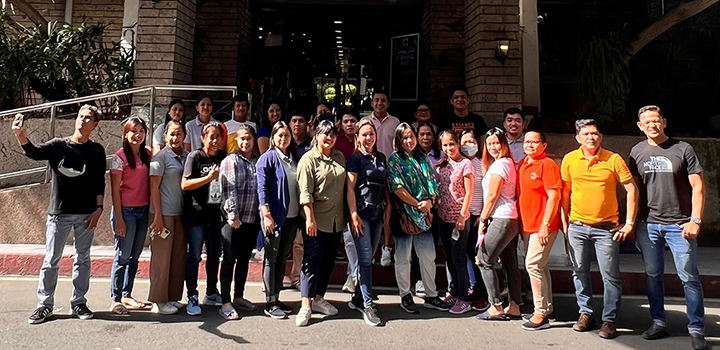UPPI-DRDF Working Paper Series 2021-01
Is It Too Late to Fall in Love and (Re)marry?
Grace T. Cruz
Christian Joy P. Cruz
Maria Karlene Shawn I. Cabaraban
Mark Ryan B. Paguirigan
This article draws from the results of the 2018 Longitudinal Study of Ageing and Health in the Philippines (LSAHP) 1. It provides a picture of the older Filipinos’ marital status, a significant factor affecting their well-being which has not been given enough attention in gerontological studies in the country. We examine how marriage patterns and attitudes towards love and marriage in older ages vary between older males and females and assess if their current marital status is related to loneliness.
Staying Married in Late Life
Almost all older people (OP)2 in the Philippines have been married at some point in their life. LSAHP results show that merely 3% of older Filipinos have never been married. Older males are twice as likely to be currently married (formal and informal) relative to females (67.9% and 34.3%, respectively). Marital unions are mostly legal (91%) with a small fraction in informal unions (9%). Married older couples are mostly living together in the same household with about a fifth of them living independently with a spouse only. An insignificant proportion of those married is living apart.
Marriage among OPs is enduring. Those who are currently married with their first spouse have been married for about 43 years on average. While marriage is generally a once in a lifetime experience, about 1 in 10 of them have been married at least twice. Those who remarry are more likely to opt for an informal rather than a legal union. This is evident in the high prevalence (72%) among those in live-in arrangements who claim to be married at least twice. For the formally married, only 12% say they have been married at least two times.
Unlike males, older females are mostly widowed. About 3 in 5 older females are widowed as compared to 1 in 5 for males. Only a small proportion (7%), slightly more females are separated, divorced, or annulled.
The stark gender difference in the marital status of Filipino OPs can be attributed to the greater propensity among males to remarry. Studies show that females are better able to navigate life after the loss of their spouse because they have a wider social network and activities. They can also take care of their own daily needs. This is opposed to the widowers who often do not have a network of friends or family members to fall back to, may have difficulty expressing their emotions to facilitate grief, and may have been very dependent on their mates for routine tasks such as cooking, cleaning, etc. (Carr and Bodnar-Deren, 2009). These findings are borne out in the LSAHP data which shows significant differentials in the level of loneliness by marital status. Particularly, married older males are more likely to say they never or rarely feel a lack of companionship in contrast to those divorced or separated who are most likely to feel a lack of companionship. Females on the other hand do not show significant variations in their feelings of loneliness regardless of their marital status. It is significant to note however that for those not currently in union (never married, divorced, separated, and widowed), the majority never or rarely feel a lack of companionship which suggests that the absence of a spouse does not always correlate with loneliness. LSAHP findings also show that married males are significantly more involved in religious activities outside the home compared to those who are not married. Females in contrast show no difference in their attendance in religious activities outside the home across marital status groups.
Longer female life expectancy is another reason for the marked gender difference in the marital status of Filipino OPs. The 2015 estimates show that Filipino females who live to celebrate their 60th birthday can expect to survive 21 more years on average compared to 17 to males (Philippine Statistics Authority, 2010). This translates to more females than males surviving to older ages. At age 60, for example, there are 94 males to every 100 females with the ratio becoming even more lopsided with advancing age.3 This means that they have fewer surviving male counterparts available as suitable marital partners. Older females’ limited pool of potential partners may also be affected by the cultural norm of males marrying females younger by about 2.7 years on average (Kabamalan and Villaver, 2016).
Is it too late to fall in love and remarry?
OPs seem less accepting towards falling in love and getting (re)married at older ages. This is particularly true among older females where only about one-fourth (24%) approve the idea of OP falling in love, with an even lower proportion (16%) expressing openness to (re)marry even if they find a suitable partner. On both counts, significantly more males are more open to the idea, albeit still at minority levels (41% and 29%, respectively).
What are the possible barriers that may explain the OP’s resistance to enter into romantic relationships and marriage in older ages? Studies identify several factors including among others familial disapproval – especially those of children (Bulcroft & Bulcroft, 1991; Mehta, 2002; Osmani et al., 2018). Evidence from the LSAHP seems to bear this out with OP’s adult children’s displaying a negative attitude towards these issues, albeit more accepting than their parents’ (OP) generation. Results of interviews with adult children of OPs suggest a conservative view similar to those expressed by the OPs themselves. About 40% and 34% of adult children expressed acceptance to OP falling in love and getting married at older ages, respectively. Future studies should examine how attitudes of the family in particular and society, in general, may affect the OP’s predisposition to these matters.
References:
- Bulcroft, R. A., & Bulcroft, K. A. (1991). The nature and functions of dating in later life. Research on aging, 13.
- Carr, D and S. Bodnar-Deren. (2009). Gender, Aging and Widowhood. In P. Uhlenberg (ed.), International Handbook of Population Aging (Volume 1), p 705-728. Dordrecht: Springer.
- Cruz, G.T., C.J.P. Cruz and Y. Saito (eds.) (2019). Ageing and Health in the Philippines. Jakarta: Economic Research Institute for ASEAN and East Asia (ERIA).
- Mehta, K. K. (2002). Perceptions of remarriage by widowed people in Singapore. Ageing International, 27(4), 93-107. https://doi.org/10.1007/s12126-002-1017-x
- Osmani, N., Matlabi, H., & Rezaei, M. (2017). Barriers to remarriage among older people: Viewpoints of widows and widowers. Journal of Divorce & Remarriage, 59(1), 51-68. https://doi.org/10.1080/10502556.2017.1375331
- Philippine Statistics Authority and Inter-Agency Technical Working Group. (2010). Census Based Population Projection. Quezon City: Philippine Statistics Office.
- Suggested citation: Cruz, G. T., Cruz, C. J. P., Cabaraban, M. K. S., and Paguirigan, M. R. B. (2021). Is it too late to fall in love and (re)marry? (UPPI-DRDF Working Paper Series No. 2021-01). Diliman, Quezon City: University of the Philippines Population Institute and Demographic Research and Development Foundation, Inc.
- LSAHP is the first nationally representative longitudinal study on ageing in the Philippines conducted by the Demographic Research and Development Foundation, Inc. in partnership with the Economic Research Institute for ASEAN and East Asia (ERIA).
- 60 years old or older
- Computation of the sex ratio was done by the authors using data from the 2015 Census of Population and Housing of the Philippine Statistics Authority.






